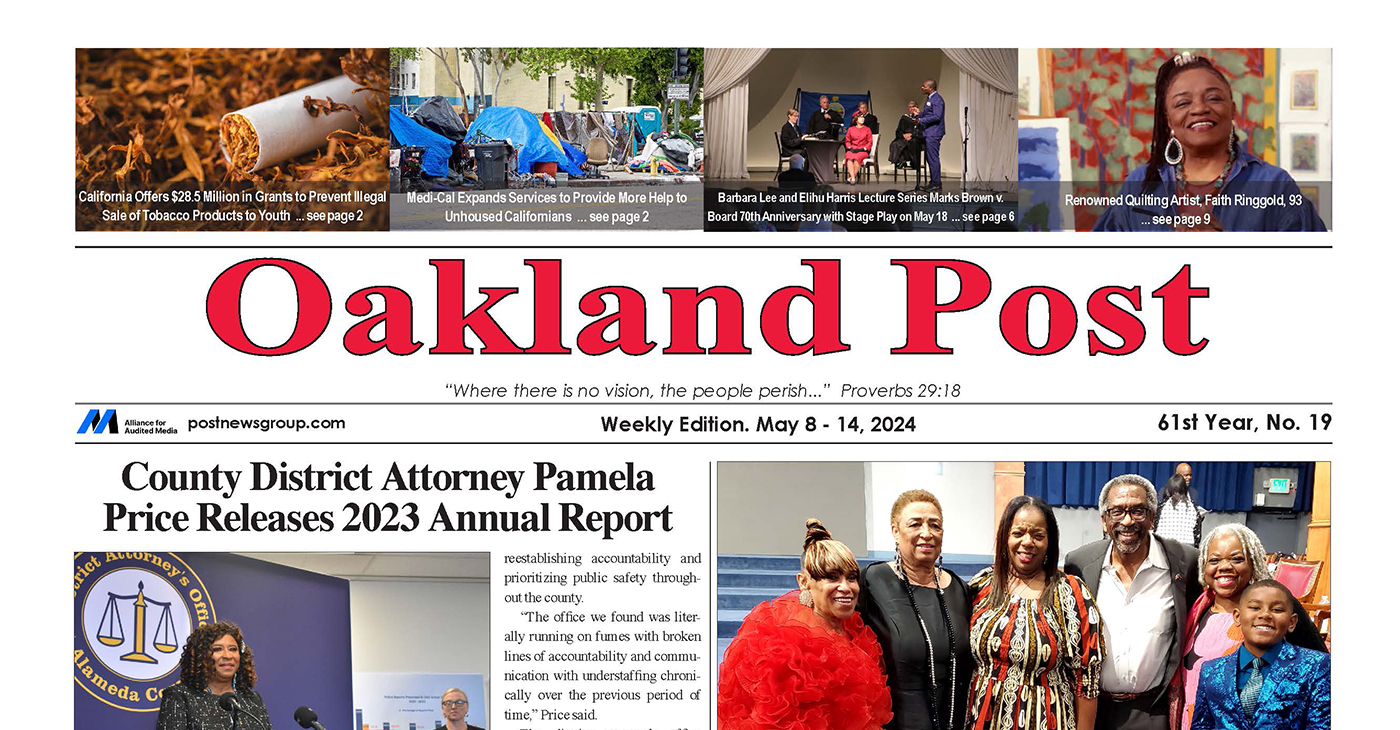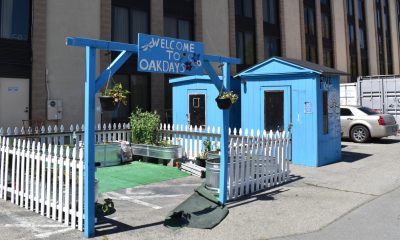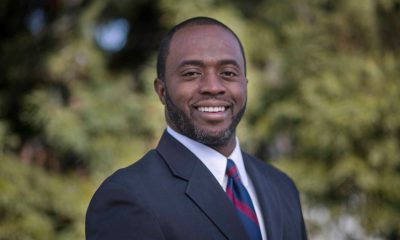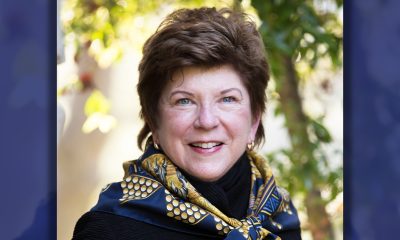Community
Make Room, Gas and Food: Insurance Payments Might Go Up, Too
According to officials at Covered California, monthly premiums for insurance coverage could jump by as much as 100% — or an average of about $70 — for more than 2 million Californians if federal government subsidies provided by the American Rescue Plan are allowed to expire at the end of 2022.

By Tanu Henry, California Black Media
As gas and food prices continue to shoot up at a rapid clip, Californians might be hit with sticker shock from another bill that skyrockets later this year: their health insurance premiums.
According to officials at Covered California, monthly premiums for insurance coverage could jump by as much as 100% — or an average of about $70 — for more than 2 million Californians if federal government subsidies provided by the American Rescue Plan are allowed to expire at the end of 2022.
An estimated total of 14 million Americans could be affected by the price increase.
“The American Plan built on the Affordable Care Act and provided more financial help than ever before to help people get covered and stay covered largely in response to the pandemic,” said Peter V. Lee, former executive director of Covered California.
Lee was speaking during a press briefing held earlier this month to inform the public about what he sees as an impending crisis if the federal government does not take action.
As a sidenote during that virtual meeting, Lee announced that he was stepping down from Covered California.
In February, the agency’s Board of Directors announced Jessica Altman, former Commonwealth Insurance Commissioner of Pennsylvania, as Covered California’s new chief executive officer.
Lee said funds the federal government currently provides to states to help lower health care premiums for Americans led to record numbers in enrollment across the country, including about 1.8 million new signups in California.
The largest increases in enrollment in California were among African Americans and Latinos.
About 90% of Covered California enrollees have received discounts on their premiums through the program.
“The American Rescue Plan increased affordability by paying a bigger share of consumers’ monthly premiums. As a result, the portion that consumers pay dropped significantly by 23% nationally and 20% here in California,” said Lee.
“Those are big drops. That meant that two-thirds of our consumers were eligible for a plan that cost $10 or less,” Lee continued. “For a lower income consumer, low cost is a critical ingredient for getting and keeping coverage.”
Covered California is the Golden State’s federally subsidized public insurance marketplace where individuals and businesses can purchase health care plans.
Lee said nearly $3 billion from the American Rescue Plan allowed California to subsidize the insurance costs of more middle-income people. The eligibility window expanded to include Californians earning up to $52,000 as a single person or $106,000 as a family of four.
Before help from the American Rescue Plan kicked in there were hundreds of thousands of Americans paying up to 30% of their income for insurance, according to Covered California.
If the federal supplement expires, “those who can least afford it would be hit the hardest,” warned lee.
Lee says the program is helping more middle-income people than ever before.
“In California today, about 1 out of 10 of our subsidized enrollees earn above 400% of the poverty level. They are getting financial help that is needed and meaningful,” said Lee. “Without the extension of the American Rescue Plan, those gains would be wiped away and consumers would be faced with staggering cost increases.”
Lee says if the federal subsidies expire, the loss of funding will also hurt people who do not qualify for the subsidies and pay for insurance at market rates.
He estimates, for Californians earning more than $52,000 a year, their premiums could increase by an average of more than $270 per month or nearly $3,000 annually.
“As people drop their coverage, the rising premiums would be felt by everyone. When you price people out of coverage, people that drop coverage first are healthy people. If you’re sicker, you keep your coverage,” said Lee.
“What does that mean? If the American Rescue Plans subsidies are not continued, we are very likely to see a premium spike. As health plans say, ‘next year will be the year we have fewer insured people, they are going to be sicker on average, we are going to have to boost our premiums,’” Lee emphasized.
If the U.S. Congress does not act to make the subsidies permanent — or at least to extend them — Californians will first see the new increased amount of their monthly premiums in the fall when they receive their renewal notices for 2023.
Activism
Oakland Post: Week of May 8 – 14, 2024
The printed Weekly Edition of the Oakland Post: Week of May May 8 – 14, 2024

To enlarge your view of this issue, use the slider, magnifying glass icon or full page icon in the lower right corner of the browser window. ![]()
Activism
S.F. Black Leaders Rally to Protest, Discuss ‘Epidemic’ of Racial Slurs Against Black Students in SF Public School System
Parents at the meeting spoke of their children as no longer feeling safe in school because of bullying and discrimination. Parents also said that reported incidents such as racial slurs and intimidation are not dealt with to their satisfaction and feel ignored.

By Carla Thomas
San Francisco’s Third Baptist Church hosted a rally and meeting Sunday to discuss hatred toward African American students of the San Francisco Unified School District (SFUSD).
Rev. Amos C. Brown, president of the San Francisco NAACP and pastor of Third Baptist Church, along with leadership from local civil rights groups, the city’s faith-based community and Black community leadership convened at the church.
“There has been an epidemic of racial slurs and mistreatment of Black children in our public schools in the city,” said Brown. “This will not be tolerated.”
According to civil rights advocate Mattie Scott, students from elementary to high school have reported an extraordinary amount of racial slurs directed at them.
“There is a surge of overt racism in the schools, and our children should not be subjected to this,” said Scott. “Students are in school to learn, develop, and grow, not be hated on,” said Scott. “The parents of the children feel they have not received the support necessary to protect their children.”
Attendees were briefed last Friday in a meeting with SFUSD Superintendent Dr. Matt Wayne.
SFUSD states that their policies protect children and they are not at liberty to publicly discuss the issues to protect the children’s privacy.
Parents at the meeting spoke of their children as no longer feeling safe in school because of bullying and discrimination. Parents also said that reported incidents such as racial slurs and intimidation are not dealt with to their satisfaction and feel ignored.
Some parents said they have removed their students from school while other parents and community leaders called on the removal of the SFUSD superintendent, the firing of certain school principals and the need for more supportive school board members.
Community advocates discussed boycotting the schools and creating Freedom Schools led by Black leaders and educators, reassuring parents that their child’s wellbeing and education are the highest priority and youth are not to be disrupted by racism or policies that don’t support them.
Virginia Marshall, chair of the San Francisco NAACP’s education committee, offered encouragement to the parents and students in attendance while also announcing an upcoming May 14 school board meeting to demand accountability over their mistreatment.
“I’m urging anyone that cares about our students to pack the May 14 school board meeting,” said Marshall.
This resource was supported in whole or in part by funding provided by the State of California, administered by the California State Library via California Black Media as part of the Stop the Hate Program. The program is supported by partnership with California Department of Social Services and the California Commission on Asian and Pacific Islander American Affairs as part of the Stop the Hate program. To report a hate incident or hate crime and get support, go to CA vs Hate.
Bay Area
Mayor London Breed: State Awards San Francisco Over $37M for Affordable Housing
On April 30, Mayor London N. Breed announced San Francisco has been awarded more than $37.9 million in funding from the California Department of Housing and Community Development (HCD) as part of the State’s Multifamily Housing Program (MHP). The HCD loan will provide the final funding necessary for development of Casa Adelante – 1515 South Van Ness, a 168-unit affordable housing project located in San Francisco’s Mission District.

By Oakland Post Staff
On April 30, Mayor London N. Breed announced San Francisco has been awarded more than $37.9 million in funding from the California Department of Housing and Community Development (HCD) as part of the State’s Multifamily Housing Program (MHP).
The HCD loan will provide the final funding necessary for development of Casa Adelante – 1515 South Van Ness, a 168-unit affordable housing project located in San Francisco’s Mission District.
The new development at 1515 South Van Ness Ave. will provide 168 affordable homes to low-income families, formerly homeless families, and persons living with HIV earning between 25-80% of the San Francisco Area Median Income (AMI).
In addition, the project is anticipated to provide family-friendly amenities and ground floor community-serving commercial spaces that preserve the prevailing neighborhood character of the Calle 24 Latino Cultural District.
“This funding unlocks our ability to move on building affordable housing units for families in San Francisco at a crucial time. We understand the level of need for more housing that is accessible, and like the state, the city continues to face a challenging budget cycle,” said Breed. “1515 South Van Ness is a good example of what can be achieved in San Francisco when you have strong community partnerships and an unwavering commitment to deliver on critical needs for our residents.”
“From the beginning of my term as Supervisor, I have fought to bring affordable housing to 1515 South Van Ness” said Supervisor Hillary Ronen. “In the interim, the site has been utilized for homeless services and shelter, and I am thrilled that HCD has recognized the value of this development, and we are finally ready to break ground and bring 168 affordable homes to low income and formerly homeless families in the Mission.”
Owned and occupied by McMillan Electric Company until 2015, the City and County of San Francisco purchased 1515 South Van Ness Avenue in June 2019 with the intent of developing new affordable housing.
In November 2020, the San Francisco Mayor’s Office of Housing and Community Development (MOHCD) released a Multi-site Request for Qualifications (RFQ) seeking qualified developers to build affordable housing on the site, and subsequently selected Chinatown Community Development Corporation (CCDC) and Mission Economic Development Agency (MEDA) in May 2021 to develop the site.
The project is expected to begin construction in winter 2025.
“A strong, long-term push by Mission advocates to make this site 100% affordable is now paying off, with 168 family units that include services and childcare. People of color communities know what they need, and we are excited to be in partnership with a team, consisting of MEDA, CCDC, and MOHCD, that listens,” said Malcolm Yeung, Executive Director at CCDC.
“We are excited to be in partnership with CCDC, yet again, and for the opportunity to develop intergenerational affordable housing in the City’s Mission District,” said Luis Granados, executive director at MEDA.
Increasing housing affordable to lower-income and vulnerable residents is a key priority in the City’s Housing Element which calls for additional funding for affordable housing production and preservation, as well as Mayor Breed’s Housing for All Executive Directive that sets out the steps the City will take to meet the bold goal of allowing for 82,000 new homes to be built over the next eight years.
Tuesday’s funding announcement emphasizes the importance of regional and state collaboration in order to reach our housing and climate goals.
“We are thrilled—not just to bring a project of this size to a community with great need — but to do so with community-based developers and their partners who understand the neighborhood and sensitivities around cultural preservation,” said HCD Director Gustavo Velasquez.
-

 Community4 weeks ago
Community4 weeks agoFinancial Assistance Bill for Descendants of Enslaved Persons to Help Them Purchase, Own, or Maintain a Home
-

 City Government1 week ago
City Government1 week agoCourt Throws Out Law That Allowed Californians to Build Duplexes, Triplexes and RDUs on Their Properties
-

 Activism2 weeks ago
Activism2 weeks agoOakland Post: Week of April 24 – 30, 2024
-

 Business4 weeks ago
Business4 weeks agoV.P. Kamala Harris: Americans With Criminal Records Will Soon Be Eligible for SBA Loans
-

 Activism4 weeks ago
Activism4 weeks agoOakland Post: Week of April 10 – 16, 2024
-

 Community4 weeks ago
Community4 weeks agoAG Bonta Says Oakland School Leaders Should Comply with State Laws to Avoid ‘Disparate Harm’ When Closing or Merging Schools
-

 Community3 weeks ago
Community3 weeks agoRichmond Nonprofit Helps Ex-Felons Get Back on Their Feet
-

 Community3 weeks ago
Community3 weeks agoOakland WNBA Player to be Inducted Into Hall of Fame




















































